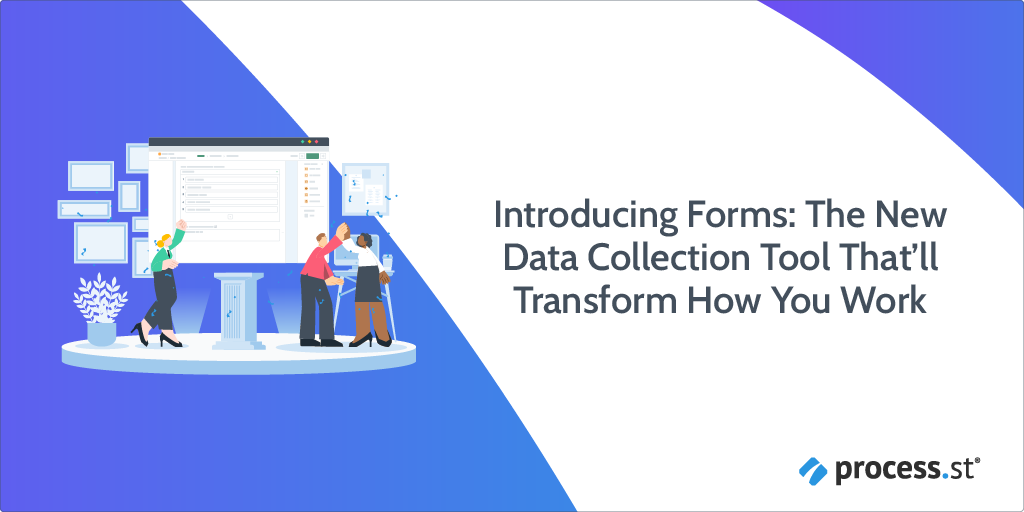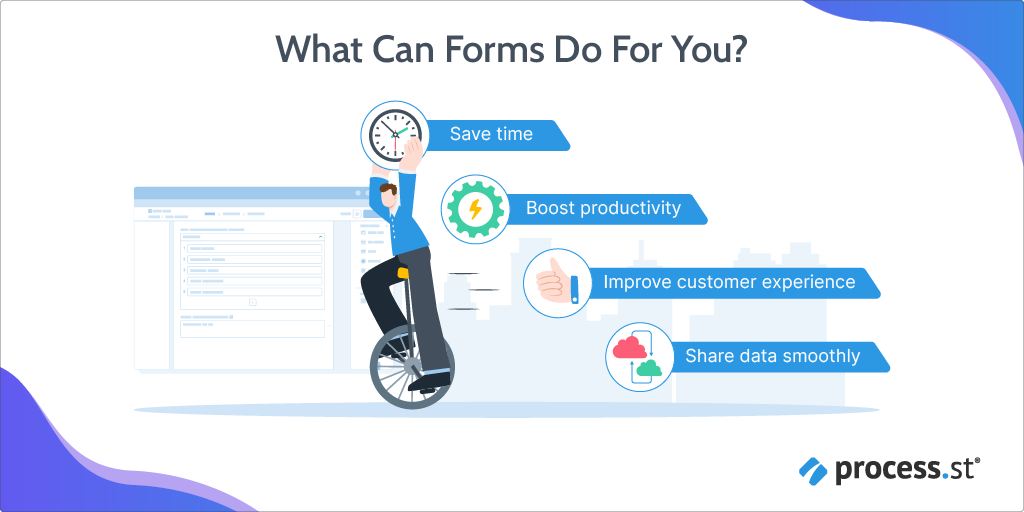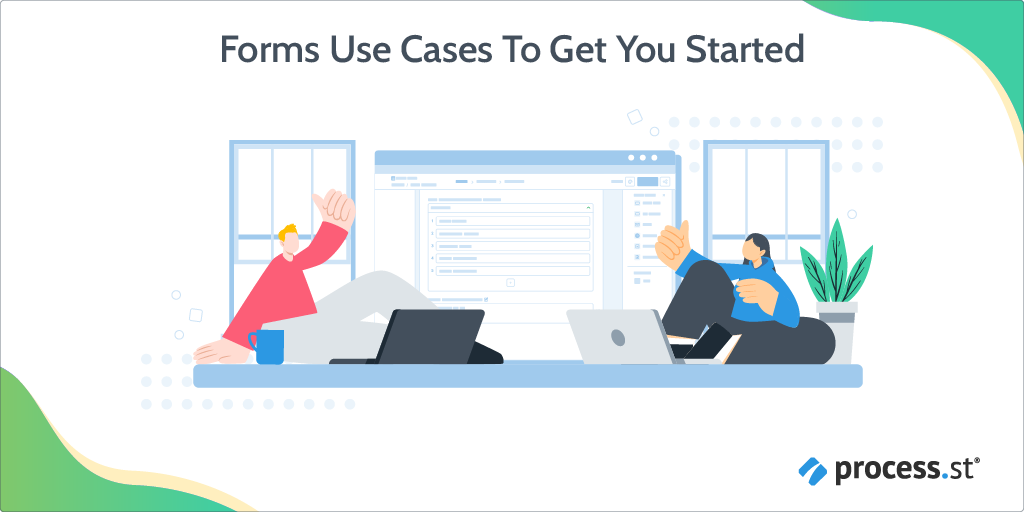
Are you tired of getting bogged down by tedious and repetitive tasks, such as manual data entry for intake forms or job applications?
Do you want to collect feedback from customers but find yourself constantly chasing them for bits of information?
Are you finding it difficult to gather attendee email addresses for an upcoming webinar?
Well, fear not!
Our Forms data collection tool will revolutionize how you collect data. Here’s how:
- If you find yourself inputting data manually, Forms will save you time.
- Struggling to collect information for a workflow? Forms will do it for you.
- Collecting data in different ways or formats? Forms will ensure workflow consistency.
- Dealing with delays due to missing or inaccurate data? Collect data upfront with Forms!
In this blog post, I’m going to dive deep into Forms and explore why they’re useful and what they can do for you.
So, grab a cup of coffee, sit back, and let’s explore the wonderful world of Forms.
What can our Forms data collection tool do for you?

Forms are like a superhero that helps you collect data and make your workflows even more powerful.
They swoop in, save the day, and make your life easier.
With Forms, the data collection process will go from mess to success! No more scattered emails or phone calls; all your data will be in one place, making it easier to manage and analyze.
In other words, Forms are a speedy and effortless means of gathering data from a large audience. Whether you’re conducting surveys, soliciting feedback, running polls, gauging customer satisfaction, or processing orders, forms allow your users to submit information of any type from any location, at any time.
Incomplete data
How many times have you gotten a form submission that was missing key information? Luckily with Forms, you can make fields required, which means your form-fillers won’t be able to submit until they’ve provided all the necessary data. Problem solved!
Inconsistency
Forms will remove inconsistencies in your workflows by allowing you to create standardized templates for all your team’s tasks. This ensures that everyone follows the same process and consistently delivers high-quality results every time.
Delayed workflows
Don’t let delayed workflows bring you down! Forms let you streamline your processes and reduce delays. Our forms can be configured to trigger actions like sending notifications or creating tasks, ensuring that your workflows stay on track and your team stays on top of everything.
But that’s not all.
With Forms, you will be a step away from fully automating your workflows, saving tons of time in the process.
How? By minimizing manual entry even more than before. Think about it, your workflows may already be 80% automated. But until now, you were having to manually input data into fields, am I right? Well, with Forms, this is no more. You can now gather all your data in one place. This data can then be automatically populated into other workflows, too.
And have I mentioned how much more productive your team will become? That’s right, because of the new automation capabilities of your workflow, the number of errors you get will drastically reduce, hence productivity will skyrocket! Forms will also streamline team collaboration by allowing them to share data smoothly. Wave goodbye to the constant back-and-forth communication.
Plus, Forms will improve customer experience because customers will be able to quickly provide you with what you need. No need to chase them for pieces of information.
That being said, unlike workflows which are very collaborative, Forms are meant to be used by a single person. This means that even though they will streamline your overall workflow use by allowing you to reduce manual data entry, they are separate from workflows. Instead, both work in tandem to make recurring work much more efficient!
Forms use cases to get you started

With all the important information out of the way, let’s move on to some of the best use cases for Forms.
Intake forms
If you use intake forms to collect important information from customers, clients, or patients, the Forms feature is going to revolutionalize the way you work!
Providing personalized service is everything. It can mean the difference between keeping or losing clients.
Why? Because customers will always remember a poorly designed experience.
Do you want to be remembered for providing 5-star customer service? Then this is where Forms come in.
The information you gather with Forms can then be used to better understand the customer’s needs and preferences and to provide highly individualized service.
Whether you’re a:
- Healthcare provider gathering medical history
- Insurance company collecting claims information
- Creative agency taking on a new project
Intake Forms allow you to gather all your data upfront. They are essential if you require structured data collection from new customers or clients.
One of the key benefits of using Forms for intake is the ability to customize the form to your specific needs.
You can include fields to collect basic contact information and more detailed information such as preferences, interests, or medical history. Storing all these details in one place will streamline the intake process and reduce the likelihood of errors or missed information.
Forms also make it easy to completely automate the intake process. You can use custom fields to automatically trigger follow-up tasks or notifications based on the customer’s responses.
For example, if a customer selects interest in a particular service, you can automatically assign a team member to follow up with them.
Say goodbye to messy paper forms and hello to efficient data collection!
Job applications
The hiring process, and job applications in particular, can be tedious and time-consuming for both the employer and the job seeker. However, this process can be simplified, making it a win-win situation for both parties.
With Forms, employers will easily compare and analyze the data they receive from applicants. Job seekers, on the other hand, benefit from the ease and convenience of submitting applications online.
Here are some examples of how you can use Forms for job applications:
- Basic contact Information – name, phone number, and email address.
- Employment history – previous employment history, job titles, and responsibilities
- Education and certifications – education and any certifications they may hold
Forms come with some of its own features that may prove useful in the hiring process.
For example, by using multi-step forms, you can break the application down into logical sections, making it super easy for applicants to complete. And to make the experience more straightforward, include conditional logic to hide or display fields based on previous answers.
Surveys and feedback
Never underestimate the importance of surveys and feedback!
Unfortunately, collecting feedback from customers or employees is often daunting. Yet, it is an essential aspect of any business. It’ll help you discover what people think about how you run the company, the quality of your products, and more.
With Forms, you can collect feedback in a much simpler way. Use a variety of field types, including rating scales and open text fields, to gather responses.
You can also set required fields to ensure respondents give you all the information you need.
Forms will help you analyze the feedback, identify areas for improvement, and take action to make meaningful changes.
For example, let’s say you recently launched a new product and want to gather feedback from your customers.
You can create a Form in Process Street that includes questions about the user experience, the quality of the product, and suggestions for improvement. You can then use the responses to identify areas where your product can be improved.
Another example is using Forms to gather employee feedback.
Create a Form that asks employees for feedback on company policies, work environment, and growth opportunities. This information can help you identify areas where your company can improve and create a better working environment for your employees.
Customer information
One of the key benefits of using forms to collect customer information is that it allows you to easily organize and store important data in a structured way.
For example, imagine you run an e-commerce business selling a range of products.
By using a form to collect information from your customers, you can gather important data such as their location, age, gender, and interests. Use this information to personalize customers’ shopping experiences, such as recommending products they may be interested in based on their previous purchases or interests.
And if you own a restaurant, you may need to find out your customers’ food preferences and allergies, helping them tailor their menus and provide better customer service.
Collecting customer information through forms can also help you improve your marketing strategy.
For instance, if you have a form that asks customers how they heard about your business, use that information to determine which marketing channels are most effective.
Event registration
Another great use case for Forms is event registration.
Whether you’re hosting a webinar, conference, or other type of event, Forms can help you collect attendee information quickly and easily.
With Forms, you not only create custom fields to collect basic information. You can even include a drop-down menu to allow attendees to select their ticket type or session preferences.
Forms also make it easy to acquire specific information from attendees, such as their email addresses, ensuring you have all the necessary details to follow up with them after the event.
In addition, you can use Forms to collect feedback from attendees after the event has ended, allowing you to improve your future events based on their suggestions and preferences.
One of the most significant advantages of using Forms for event registration is the ability to automate the process.
Forms let you collect information from attendees in one place and have it automatically added to your contact list or CRM system.
Another great feature of Forms for event registration is the ability to use conditional logic. This means that you can create different fields or questions based on the attendee’s previous answers.
For example, if an attendee selects that they are interested in a specific session, you can automatically show them a follow-up question related to that session.
Forms also make it easy to manage registration for events with multiple sessions or ticket types. You can use custom fields to allow attendees to select which sessions they want to attend and which ticket type they want to purchase.
Best practices for using Forms
Before I take you through how to use Forms, it’s useful to learn some best practices first.
Be clear and concise
When creating Forms, make sure your fields are easy to understand and use. Utilize clear and concise language, and keep the number of fields to a minimum. Remember, the goal is to make it easy for users to fill out the Form and provide you with accurate information.
Pass Forms into workflows/Data Sets
Passing Forms into workflows allows you to easily automate tasks and ensure important information isn’t missed.
For example, imagine you have to collect client information for a new project. By passing that form into a workflow, you can automatically create tasks for team members to:
- Follow up with that client
- Send out contracts
- Ensure that all necessary information is gathered before the project begins
Test your Forms
Before releasing your Form to a wider audience, test it with a small group of users to identify any issues or areas for improvement. This will help catch errors or usability problems before they become bigger issues.
Use form responses to continuously improve
Don’t just collect data for the sake of it – use the responses you receive to improve business processes. Look for trends in the data and use them to identify areas where you can make improvements or changes.
For example, if you notice that many customers are having trouble with a particular product feature, you can use that information to prioritize improvements and updates.
Make use of advanced features
Process Street’s Forms feature offers a range of advanced features, including field validation, required fields, multi-step forms, and conditional logic.
Take advantage of these features to collect more accurate and complete data while also improving the user experience.
Keep your Forms up to date
Over time, business needs and processes may change, which means your Forms may need to be updated.
Review and update your Forms regularly to ensure they are still meeting your needs and collecting the information you require.
How to use Forms?
You probably can’t wait to start using the Forms feature and are excited to make your workflows better than ever.
Let me give you a brief tour of how to incorporate Forms into your life right now.
Step 1: Log in to Process Street
To get started, simply log in to your Process Street account and click on “New Template.” This will take you to the template editor, where you can start building your template.
Step 2: Add a Form field
Next, you’ll need to add a Form field to your template. This is where you’ll collect information from team members or customers.
To do this, click “Add New Element” in the template editor and select “Form Field” from the dropdown menu.
Here, you can also set field validation rules and make fields required.
Step 3: Customize the Form field
Once you’ve added the Form field, you can customize it to suit your needs.
Click on the Form field to open settings to add a label, description, and any required fields. Be sure to make the Form field as clear and concise as possible so that team members or customers know exactly what information you’re looking for.
Step 4: Add custom fields and widgets
To collect more specific information, you can add custom fields and widgets to your Form field.
For example, if you’re collecting customer information, you might want to add fields for their name, email address, and phone number.
You can also add widgets like a calendar or a dropdown menu to make the Form field more user-friendly.
To use conditional logic, select the field to which you want to add a condition and click on the “Add condition” button. Then, select the appropriate condition and choose which fields to show or hide based on the user’s response.
Step 5: Automate
Finally, you can automate your workflows by using Process Street’s automation features.
For example, you can automatically send an email or create a new task based on the information collected in the Form field.
To learn more about how you could use Forms, go to our Forms help center page.
The Forms feature will transform how you work
Still wondering how? Well, Forms let you easily collect information from your team members or clients without going back and forth through countless emails or phone calls. The result? Hours of your time saved!
You can create custom forms with all the fields you need and then share them with whoever needs to fill them out. It’s like having your own personal assistant to collect data for you!
In a nutshell, Forms is going to make your life easier, your work more efficient, and your days a lot less stressful!
With Forms, you will streamline your workflows and automate data collection, making you and your team much more productive.
But that’s not all. Forms will also improve collaboration, reduce errors, and enhance customer experience.
And let’s not forget about the best part. Forms will make your work more enjoyable!
Whether you’re gathering important information from customers, collecting job applications, or seeking feedback, Forms have got you covered. With custom fields and multi-step forms, Forms will help you personalize your service and make the experience easy for your users.
So, what are you waiting for? Join the revolution of data collection and let Forms be your superhero!
Let us know how you’re using Forms in the comments below – and we might even feature you in an upcoming article.







 Workflows
Workflows Projects
Projects Data Sets
Data Sets Forms
Forms Pages
Pages Automations
Automations Analytics
Analytics Apps
Apps Integrations
Integrations
 Property management
Property management
 Human resources
Human resources
 Customer management
Customer management
 Information technology
Information technology



Anna Hase
Anna is a coffee-obsessed content writer with a master's degree in psychology. Her main area of interest is employee psychology. When she's not writing, she's either reading or lifting weights at the gym.